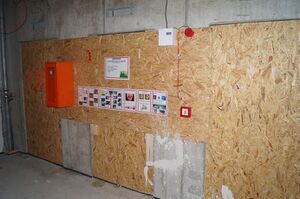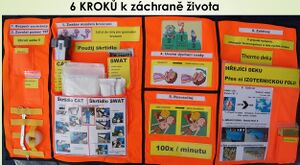Safe-point
SAFE-POINT je protokol popisující způsob efektivního poskytnutí první pomoci u dospělých za použití minimálních nutných pomůcek a základního minima znalostí.
Origin and history[edit | edit source]
The protocol was created in 2015 as a response to deficiencies in the provision of first aid also at workplaces, especially construction sites. The main idea behind this protocol is the effectiveness of first aid in connection with the maximum use of minimal resources, i.e. so that there are 90% of workers with 10% of the correct knowledge at the given workplace rather than 10% of workers with 90% of the correct knowledge. Furthermore, it was designed to eliminate as much as possible the reluctance of the lay public to provide first aid. Subsequently, it was modified for use by the general lay public.
The system was mainly created by modifying the protocol for emergency medicine in pre-hospital and hospital care ATLS® and its modificationsBATLS®.
Risks of not providing first aid to the layperson[edit | edit source]
- People watch but do not act because they are afraid to help
- People help, but the help is ineffective because they do not have the necessary knowledge
- People help, they have the necessary knowledge, but they lack the necessary equipment
External conditions for system operation[edit | edit source]
- Arrival time Medical emergency services within 20 minutes (time defined by law 374/2011 Coll. Act on medical emergency services)
- Assisted first aid over the phone on line 155
Internal conditions for the operation of the system[edit | edit source]
- Correctly applied first aid – any aid given to the affected person must be applied correctly; it is important to help but not to hurt
- Quickly applied first aid – first aid must be provided immediately, i.e. as quickly as possible
- Efficiently used resources - efficiency consists in maximizing the resulting effect, with a minimum of necessary tools and knowledge
Description of the SAFE-POINT protocol[edit | edit source]
The protocol proceeds in a strictly logical manner based on which failure of vital function causes death first, with the main priority being the safety of the rescuers (Act No. 374/2011 Coll.) Followed by a call for available help and only then, are life-saving measures taken. Moreover, if a step is not solved, it does not proceed to the next one.
1. step - Rescuers own safety[edit | edit source]
The most important point in the protocol, its use is crucial for rescuer safety. It is necessary for a potential rescuer to primarily take care of his own safety. Without it, there is a risk that in the final it will be necessary to help a larger number of people and therefore any further help will be thwarted by this faulty procedure.
The basic lesson for a potential rescuer is "No matter what happens, if your own safety is not ensured, don't rescue anyone else!!!"
The main risks are e.g. falling from a height / to a depth, possible collapse, electric shock, possibility of explosion and others.
Personal protective equipment must also be used - especially protective gloves and a mask.
2. step - Line 155[edit | edit source]
The second point in the protocol is the provision of available help, in the Czech Republic it is about dialing an emergency line. For health problems, the fastest method is to dial line 155, i.e. the Medical Ambulance Service. From this time, the legally defined 20 minutes are counted. You can of course call the pan-European number 112, but there is a time delay and the operators are not completely able to provide assisted first aid. For the effective use of this protocol, the emphasis is on a quick assessment of the situation, which should not exceed 30 seconds; it is necessary to find out what happened - we approach the victim, pinch him, find out if he is bleeding and breathing) and then dial 155, where he reports what happened and where, how many victims there are and what their condition is, their names and approximate ages and who's calling.
3rd step - massive bleeding - loss injury[edit | edit source]
The next 4 points of the protocol are based on BATLS® and address the provision of basic life functions. the first of these four steps is to stop the bleeding. The volume of saved blood fundamentally affects further chances of survival. Without blood, the next steps are unsuccessful, so it is necessary to react correctly and quickly. A simple procedure based on pressure in the wound is used for this. The wound is closed first, almost regardless of what (finger, jacket, shirt, etc.), especially quickly. This will slow down the bleeding. Tourniquet "tourniquet" type SWAT® Subsequently, it is necessary to stop the bleeding completely - in the ideal case, the bleeding is stopped with a pressure bandage, if this is not possible, it is necessary to ensure that the bleeding is stopped with a tourniquet (tourniquet). As part of the SAFE-POINT protocol, it is possible to use certified tourniquets, e.g. the CAT® tourniquet, which works on the principle of Velcro with a tightening rod, and the SWAT® tourniquet, which works on the principle of a rubber bandage. The use of a standard Esmarch tourniquet is not recommended within the SAFE-POINT protocol due to its lack of effectiveness. It is also possible to use an improvised tourniquet (never NOT a wire, etc.). If nothing else, keep pushing into the wound.
Step 4 - Free airways[edit | edit source]
The second life-saving point of the protocol is to open the airway if breathing is not detected. This is ensured by cleaning the oral cavity of all impurities (food residues, etc.) and by simply tilting the head. A necessary step within this point is to check the state of breathing, this is defined as a check lasting about 10 seconds.
The parameter of possible spinal injury is taken into account only by gentle treatment. The reason for this decision is that if breathing is not restored, any damage to the spine is irrelevant and insignificant (the patient will die anyway)
Step 5 - Resuscitation[edit | edit source]
The third VERY important point of the protocol is the initiation of cardiac massage in the event that breathing has not been restored. Further examinations are no longer carried out and the emphasis is placed on correct heart massage. This massage is performed on the center of the chest, between the nipples. The massage is performed at a frequency of 100-120 x/minute, approximately 5-6 cm deep or 1/3 of the chest.
It is emphasized that full cardiopulmonary resuscitation, i.e. incl. artificial respiration was performed only by persons trained in this skill, or in the case of specific situations (drowning, children).
The goal is "Massage, massage, massage and then everything else".
6th step - keep warm[edit | edit source]
The fourth and last life-saving point of the protocol is the protection of the body's thermal environment. This point is included in the protocol based on the fact that during serious injuries, the so-called centralization of circulation occurs, when the body in "safety mode" increases the chances of survival by protecting the most important organs (brain, heart, lungs).
The practical consequence of such a regime is the failure of body thermoregulation. Since in our conditions it is almost always colder than the temperature of the human body, you will get cold quite quickly. This results in increased mortality in the 2-3 days following the injury itself – in other words, if thermal comfort is not addressed, the risk of death is significantly higher.
With these facts in mind, care must be taken to ensure the thermal stability of the victim. The use of a passive system (isothermal film) is insufficient, which is why the SAFE-POINT protocol also includes an active heating system, e.g. the Ready-Heat II or EasyWarm blanket. Its huge advantage is that it provides heat based on a chemical reaction - it is therefore an independent source of heat. After unpacking the blanket, a chemical reaction with oxygen takes place, then it heats up and can stay warm for several hours. Subsequently, a passive system is also used, i.e. isothermal foil, which further helps maintain the temperature. This again increases the chance of the affected person's survival.
SAFE-POINT Protocol Resources[edit | edit source]
Necessary knowledge (life-saving actions only)[edit | edit source]
- use your own head and don't be afraid to help
- remember the number 155 and call medical rescue service
- be able to push into the wound
- if necessary and possible to put on a tourniquet
- perform [Cardiopulmonary resuscitation] (CPR) - at least clear the airway and perform cardiac massage
- ensure thermal comfort
System equipment (utilities)[edit | edit source]
- safety gloves
- patch
- functional large scissors
- 2 classic bandages
- 2 large squares (20 x 10 x 2 cm)
- mask for artificial respiration
- functional tourniquets (CAT®, SWAT®)
- warming blanket (ReadyHeat, EasyWarm)
- isothermal foil
- protective packaging with visual instructions for providing first aid
Links[edit | edit source]
Literature[edit | edit source]
- Advanced Life Support. 2015. ed. [s.l.]: European resuscitation council, 2015. 310 pp. ISBN 9789079157839. P. 310.
- MK CR 7977, Emergency medicine. Emergency Medicine - Special Edition. 4 times a year. 30.11.2015, year 2015, no. ISSN 1212– 1924, p. 76. [Available online].
- ERC - European Resuscitation Council (English)






